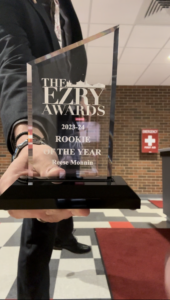On Friday, Sept., 13 President Michael Frandsen sent out a campus-wide email detailing the university’s decision to not renew the appointments of eight professors following a social media frenzy of faculty and students voicing their concerns regarding the situation.
In the email, Frandsen cited “the need to balance strategic investments with cost savings” as motivation for the cuts, and many students ultimately blamed entities ranging from the construction of “The Steemer” athletic facility to administrative mismanagement.
Rob Young, Wittenberg’s Vice President for Finance and Administration, agreed to an interview with The Torch regarding the specific financial implications leading to the faculty cuts and how Wittenberg plans to move forward.
“The financial situation is a number of different things that have been systemic and ongoing for a number of years,” Young said.
Low enrollment, however, is behind the faculty cuts.
“Enrollment peaked in 2016,” Young said. “Undergrad was around 1,830 students, so we added a few faculty positions. I’m sure the thinking in 2016, for adding the faculty positions, was that enrollment was going to continue to go up. However, 2017 was a lower class, 2018 was a lower class, and, certainly, everybody knows that 2019 was a lower class.”
Wittenberg also struggles with student retention.
“Freshmen to sophomore retention has been right around 70%, which is low for our type of institution,” Young said. “We’re not an institution, at least in the last 10 years, that has been at an 80-85% freshmen and sophomore retention. It has been somewhere between the 75% and 80% range.”
The university refinanced former bonds and debt was created from the construction of Hollenbeck and New Hall, as well as the addition onto the Science Center.
While many students and faculty have pointed to the new “Steemer” athletic facility as principal culprits, particularly in its cost exceeding original projections, Young said that the facility only accounts for a fraction of Wittenberg’s expenses.
“There is interest expense associated with The Steemer that is a piece of our deficit,” Young said. “It is a piece of it, but it’s not near as big of a piece of it as people seem to be suggesting that it is, and it’s not what has tipped us into the cuts.”
Additional causes of Wittenberg’s financial concerns include the lack of a comprehensive fundraising campaign in over 18 years and leadership turnover and instability among the senior staff, most of which is attributable to a variety of reasons.
In response to its financial straits, the university has considered several options for cost-reduction.
“Sometimes, we [the President’s senior staff] have discussions of the ‘least-worst’ choices we can make,” Young said.
“Everything we’re doing tries to minimize any impact we’re having on students, and I recognize that, in sending out letters of non-renewal to some members of the faculty, there certainly is a subset of students that will feel very impacted,” Young said.
Young also addressed an idea prevalent in some student and faculty social media posts.
“I think the notion that we’re cutting academics first is not accurate,” Young said. “The provost has recommended, through the appropriate channels, for some programs to be reviewed. We’re certainly not ‘targeting,’ in any way, academics, but one of the metrics we have is the student-to-faculty ratio, and with the drop in enrollment and the size of the faculty as it is now, that ratio is between 10:1 and 11:1. If you look at what we get in resources, such as net tuition revenue per student and endowment size, responsible fiscal management would say we need to be somewhere between 13:1 and 14:1. The only way to get there, unless you think we’re going to have 1,000 students in next year’s incoming class would be to eliminate some positions in the faculty. There is a process outlined for this, both in the institution bylaws and the faculty manual, which the faculty is responsible for and the Board approves,” Young said.
The university is considering options to reduce expenditures besides faculty cuts.
“We have an early-exit incentive plan that went out to eligible faculty, the terms of which are confidential,” Young said.
“We’re also assessing grounds and maintenance, and we’ve told our employees that–not that we are outsourcing, but that we’re evaluating whether that’s the right long term decision for the institution. On the administrative side, in my area alone, four or five positions, as they have become vacant, are not being filled. We’ve notified several other people that their positions are being eliminated,” Young said.
However, Young noted that faculty and staff positions are the biggest expense in the university budget, accounting for 55 to 60 percent of university expenses.
“There’s just not a lot of other stuff you can go and wave your wand and say, ‘eliminate half a million dollars here and that will have no effect on anybody,'” Young said.
He said Wittenberg is not alone in its financial tensions.
“Higher education, particularly private higher education, has struggled for years with containing costs and being nimble enough to add or subtract resources as enrollment grows and declines,” Young said.
“It’s not surprising to me that, every so often, we’re having a discussion about what we’re going to do. The way out of this is to strengthen underlying enrollment at a baseline, in contrast to the enrollment numbers from the past 10 years, which indicate significant swings.”
Young acknowledged the emotional effect of the financial discussions of lost faculty positions.
“I understand how this is all confusing for people who aren’t familiar with the documents and processes involved because it always feels very personal when it involves people, and it is personal to those people and those that are close to them,” Young said. “For me, as a manager, I have to remember that, and remember that right now even though it’s certainly emotional for all of us, but we have to make tough choices sometimes within the constraints that we have. We can’t just continue to say, “We’ll find the money to pay our bills because that can’t exist on a long-term basis.” We need to set this institution on the right course, right now.






Thank you for investigating and getting real information rather than simply believing the social media rhetoric. Wittenberg supposedly teaches critical thinking but I saw that from only a few students over the past week. Most were content with jumping on the bandwagon of emotional response rather than searching out information that could have helped develop a deeper understanding of a very complex situation.